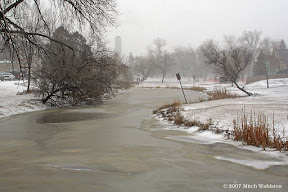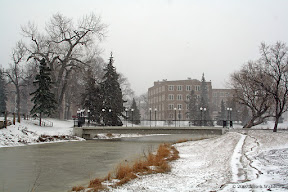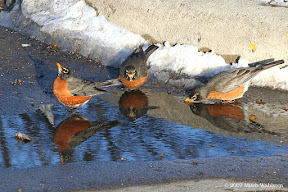Flood of '97 Series: Reopenings
The first half of May in 1997 was characterized by the sights, sounds, and oftentimes, smells of flood-recovery efforts. Those whose homes had been damaged were kept busy by the stressful task of sorting through damaged belongings and discarding everything that could not salvaged. In most cases, anything that touched the floodwaters could safely be called unsalvageable.
Preliminary estimates revealed the extent to which homes were damaged within the valley. In Grand Forks, 16,000 homes were officially declared damaged; in East Grand Forks, the number was 2,500 homes. Elsewhere, there were 600 damaged homes in Breckenridge and between 200 and 300 in Ada. Estimates for the total cost of all structures damaged were running well into the hundreds of millions of dollars.
Although the Red River had been quick to rise to bring about devastating flooding, it was taking its time to recede. By the second week of May, the flood was 1997 was still technically occurring, as all gauges along the Red River were continuing to report levels above flood stage. It wouldn’t be until May 17 that the Red would drop below flood stage at its headwaters in Wahpeton/Breckenridge. For Grand Forks and East Grand Forks, the Red didn’t drop below flood stage until May 19 – nearly a full month after it crested at 54.33 feet.
Still, even at levels above flood stage, the river was manageable at this time, and communities, large and small, that had frantically built earthen and ring dikes in the days before flooding struck were busy taking them down. Grand Forks’ temporary dikes, which were blocking streets and disrupting traffic patterns in some cases, began coming down on May 5. Elsewhere, county roads that had been cut through in order to prevent overland flooding from taking over houses and communities were slowly being repaired.
May 8 turned into a significant day for UND, since it was the day that what had been called the “virtual university” was shut down and the actual university officially reopened. Although not all staff returned to their jobs on this first day, the reopening symbolized that UND had successfully endured the flood.
Preparing residence halls to house flood-victims and relief workers continued to be a high priority for university officials, who announced on May 8 how they would apportion the available rooms. Summer session students would be housed in Selke and Noren Halls, UND employees and their families would get Brannon, McVey, and West Halls, displaced residents would be assigned to Fulton, Johnstone, and Smith Halls, relief workers and trades people to Squires Hall, and FEMA and Small Business Administration employees to Swanson Hall. Bek, Hancock and Walsh halls, still needing repairs from flood damage, would be held as backup facilities and used only if all other space filled up. “Opening day” for occupancy was set as May 10.
FEMA was instrumental in the behind-the-scenes work of getting the residence halls open to flood victims. The government agency had already announced that it would compensate the university all costs involved in providing the emergency housing, and, in turn, set up a system so that all flood victims could get the housing at no cost.
As important as May 8 was, May 12 was even more important, since it marked the start of the summer session at UND. The complete, on-time, beginning of classes, which seemed nearly unfeasible at the time it was announced during the height of flooding ended up taking place without much of a hitch. Enrollment for the summer session totaled 2,852 students – down from the previous year’s number of 3,382, but better than the earlier projection of a 30 percent decline.
Grand Forks and East Grand Forks were finally fully connected once more on May 13 after the Sorlie Bridge on DeMers Avenue reopened. The Point Bridge, another of the three bridges spanning the Red River between the two cities, reopened for traffic on May 11.
With the May 12 announcement that water within the city of Grand Forks was once more safe to drink, the city was well on its way to recovery. Just how long the recovery process would take, however, was unknown.
Check back around May 15 for a “conclusion” to this series.
Pictures related to this entry:


Sources used in writing this entry:
Orvik, Jan, and Dick Larson. The Return of Lake Agassiz: the University of North Dakota and the Flood of 1997. Grand Forks, ND: University of North Dakota, 1998.
Staff of the [Fargo] Forum, comp. Fighting Back: the Blizzards and Flood in the Red River Valley, 1996-97. Fargo, ND: Forum Communications Company, 1997.
Staff of the Grand Forks Herald and Knight-Ridder Newspapers, comp. Come Hell and High Water: the Incredible Story of the 1997 Red River Flood. Grand Forks, ND: Grand Forks Herald, 1997.
Labels: Flood of 1997, Grand Forks, UND, Weather

























